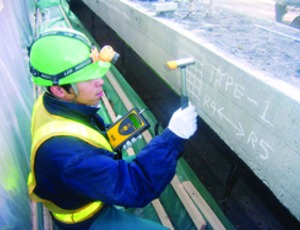
An electronic concrete test hammer, developed by a Japanese construction company looking to improve non-destructive testing tools, is now available in the U.S. market along with a stateside product representative.
Nitto Construction Co. Ltd., Monbetsu-gun, Hokkaido, Japan, began to develop the hammer after concrete delaminated and fell in the Sanyo high-speed rail tunnel in 1999.
The company was dissatisfied with testers based on the widely used rebound design developed as the Schmidt Hammer in 1948, so it began research in 2003 and took its first device to the Japanese market in 2005.
Tomoaki Sakai, a researcher at Applied Research Inc., Japan, says tests by Japan's Public Works Research Institute of the newest version—the CTS02, which was released in March—found the CTS02's variance from estimated strength to actual concrete strength to be within 15%.
“It means the accuracy of CTS02 is more than 85%,” Sakai says.
The company says the device analyzes the strength of concrete by the waveform of impact force at the point of hammer and concrete contact. A built-in accelerometer measures blow force.
The device estimates a surface deterioration value based on the rate of velocity when the hammer initially contacts the concrete, measured against the velocity of the rebound. A delamination indication value is calculated based on the existence of several local peaks on the impact waveform.
So far the company has sold 289 units, mostly in Japan and Korea, but only one—to an undisclosed purchaser—in the U.S. Users primarily are civil and structural engineers in government agencies at the prefectural and municipal levels, the company says.
The device sells for $8,900 FOB Chicago. The U.S. representative is A-Lex International Consulting LLC, Inverness, Ill.



Post a comment to this article
Report Abusive Comment